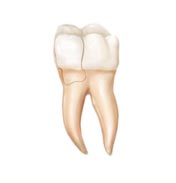
What is Cracked Tooth Syndrome?
Cracked Tooth Syndrome is a dental condition characterized by symptoms of sharp pain on chewing without any visible reason, which is actually caused by a ‘hidden’ crack of the tooth.
Teeth that cause cracked tooth syndrome usually have fractures that are too small to be seen on X-rays. Sometimes the fracture is below the gum line, making it even more difficult to identify.
Dental Health Risks of Cracked Teeth
Cracked tooth syndrome is a condition that has to be identified and treated early enough before the damage puts the tooth at risk. If the crack reaches the pulp chamber of the cracked tooth, the pulp tissue becomes exposed to bacteria and bacterial toxins, and gets inflamed developing a tooth infection.
An untreated cracked tooth can result in pulpal necrosis (death of the nerve), and tooth abscess (infection) requiring root canal treatment. In severe cases the tooth can split in two reducing the chances to fix the cracked tooth and usually tooth extraction is necessary.
The fact that people today live longer and keep their teeth for more years increases the risk of having a fractured tooth and experiencing cracked tooth syndrome problems.
Why Cracked Teeth cause Pain?
If the crack extends to the pulp chamber, chewing can cause movement of the cracked piece of the tooth and the pulp becomes irritated; resulting in a momentary, sharp pain. The pain as cracked tooth syndrome symptom is similar to the pain experienced in cases of severe tooth sensitivity. Continuous irritation of the pulp during chewing may damage the pulp, and the tooth may start to hurt without any external stimulation.
A fractured tooth may hurt even if the crack has not reached the pulp. If the crack extends up to the dentin, the tiny movement of the cracked piece on chewing causes a movement of the fluids in the dentin’s microtubules resulting in a sharp sensitivity-like pain.
Causes of Cracked Tooth Syndrome
Cracked tooth syndrome is caused by a crack on the tooth. Fracture teeth are becoming more common as people keep their natural teeth longer. Beside the extended time that teeth are used, the number of dental procedures performed on each tooth is increasing making them more susceptible to cracking.
Cracked tooth syndrome symptoms may be caused by fractures developed due to a number of reasons:
- Natural wear. Over the years, the repetitive everyday use of the teeth for biting and chewing may cause cracks on teeth.
- Clenching or grinding teeth (bruxism) is one of the major causes of fractured tooth syndrome. Grinding and clenching puts teeth under excessive pressure making them more susceptible to cracks.
- Bad chewing habits such as biting pencils or chewing on hard foods.
- Trauma to the mouth.
- Large fillings can weaken the teeth resulting in tooth fracture.
- Untreated extensive tooth decay.
- Complications during/after endodontic therapy. Sometimes the pressure applied on a tooth during root canal treatment may cause a crack.
- After a root canal treatment teeth become brittle and they are more susceptible to cracked tooth syndrome.
Symptoms of Cracked Tooth Syndrome
The patient generally experiences sharp pain when he applies biting pressure in a certain area of his mouth, but he frequently cannot tell which particular tooth hurts. Minor tooth fractures are unlikely to cause symptoms, so the problem may exist for a long time before the cracked tooth syndrome symptoms appear.
The symptoms of cracked tooth syndrome include:
- Tooth sensitivity to hot and cold temperatures.
- Pain in the tooth upon biting or chewing. Pain is not constant as that in case of tooth decay or tooth abscess. The tooth may be painful only when eating certain foods or when chewing in a specific way. If the pain is usually experienced upon release of biting pressure, it is a sign that it is a case of cracked tooth syndrome.
- If the crack is severe, there may be signs of increased tooth mobility.
Diagnosis of Cracked Tooth Syndrome
Diagnosis of cracked teeth is often difficult, because the crack may not be visible. This is actually the characteristic of cracked tooth syndrome; symptoms of sharp pain without the dentist to be able to see any problem with the tooth, either by clinical examination of the mouth, or sometimes neither by radiography (x-rays). A detailed dental history, focusing especially in history of trauma, bruxism, chewing habits and bite adjustments, can help significantly in the diagnosis of cracked tooth syndrome.
The dentist will first identify which tooth has the problem. This is done by a biting test using an instrument that rests on one tooth at a time. After the tooth is identified the test is performed on each of the cusps of the tooth in order to have a more precise location of the problem.
The dentist will perform a thorough examination of the tooth, checking for any signs of problem that could explain the symptoms e.g. tooth decay or fractures. A sharp instrument called an explorer is used to feel for cracks on the tooth and probe the gums around the tooth to feel for irregularities under the gum line.
X-rays usually do not show the small cracks that cause cracked tooth syndrome. Only if the cracks are wide enough, they may show up as shadows. In some cases of old vertical root fractures, vertical bone loss parallel to the root fracture can be seen in x-rays. In case of a cracked root in a tooth with a restoration, it can be quite difficult to verify cracked tooth syndrome without removing the restoration. Sometimes a special dye might be used to temporarily stain the tooth, and check to see if it is fractured.
After identifying the cause of the cracked tooth syndrome, the dentist will recommend the most suitable way to fix the cracked tooth.
Treatment of Cracked Tooth Syndrome - How to fix a cracked tooth?
The treatment for cracked tooth syndrome depends on the type, location, and severity of the crack. But you must know that a fracture in a cracked tooth will never completely heal, as it happens with a broken bone. Therefore, cracked tooth treatment is focusing in enhancing the structural strength of the tooth and preventing the crack from becoming worse and causing a broken tooth. Even after treatment, it is possible that a crack may continue to expand, resulting in the loss of the tooth.
If the crack has affected only the outer layers of the tooth (enamel / dentin), only a restoration such as tooth bonding that will hold the tooth together is needed. The recommended solution is usually a crown, which provides better structural stability to the tooth. If the fracture has reached the center of the tooth and the dental pulp has been infected, the tooth must have endodontic treatment (root canal) before it is restored.
Unfortunately, cracked tooth treatment is not always successful. In some cases, such as in vertical root fractures (split root) in single rooted teeth, the only treatment option is tooth extraction. If the dentist decides that the tooth needs to be extracted, it must be replaced by an implant or bridge.
Early diagnosis of a fractured tooth can be very important for the future of the tooth. If detected early enough, with the proper treatment, the tooth can be retained for a long time despite the crack. If the crack is left untreated, complications like tooth infection, abscess or breaking of the tooth may lead to loss of the tooth. Repair of any tooth thought to be cracked is always risky, and no guarantees can be made about the outcome.
There are several types of tooth fractures, each requiring different treatments to fix a cracked tooth. These include:
- Craze lines — Superficial fractures that affect only the tooth's enamel and rarely cause cracked tooth syndrome. Only light polishing of the tooth to smooth out any rough spots may be needed mainly for cosmetic reasons.
- Minor cracks/chips — Minor cracks affect only the outer layers of the tooth. An amalgam or composite filling may be needed to repair the damage, if the damage can not be restored by just smoothing the tooth surface. Porcelain veneers can also provide excellent cosmetic results.
- Cusp fractures — These affect only the pointed chewing surfaces (the cusps) of the teeth and not the pulp of the tooth. Minor cusp fractures are repaired by filing the surfaces of the tooth to restore the shape of the tooth. If the crack is extensive an onlay or crown is required.
- Cracked teeth — Serious fractures that affect the pulp of the tooth. Endodontic treatment (root canal) is necessary followed by crown restoration. If the crack extends below the gum line, periodontal surgery may be necessary to expose the crack so that a crown can be placed.
- Split tooth — The tooth has split vertically into two separate parts. The larger of the two parts of a multi-rooted split tooth may be saved after root canal treatment and crown restoration. The rest of the tooth has to be removed. However in many cases the tooth will have to be extracted.
- Split root — These are vertical cracks of the root of the tooth. In cases of single-rooted teeth, the tooth will have to be removed. In multi-rooted teeth the dentist will try to save the tooth by removing only the affected root with endodontic surgery (apicoectomy).
Prevention of Cracked Tooth Syndrome
It is not possible to prevent all the cracks that could cause a cracked tooth syndrome, but you can decrease the risk if you follow these recommendations:
- Stop bad chewing habits such as biting pencils.
- Don't clench or grind your teeth. Wear a night-guard at sleep.
- Wear a mouth guard when playing contact sports
![]() The cost involved with restoring a cracked tooth can be significant and many patients may not afford it if they are not covered by their dental insurance.
Learn how to choose a dental insurance plan that will provide the best dental treatment to yourself and your family.
The cost involved with restoring a cracked tooth can be significant and many patients may not afford it if they are not covered by their dental insurance.
Learn how to choose a dental insurance plan that will provide the best dental treatment to yourself and your family.


